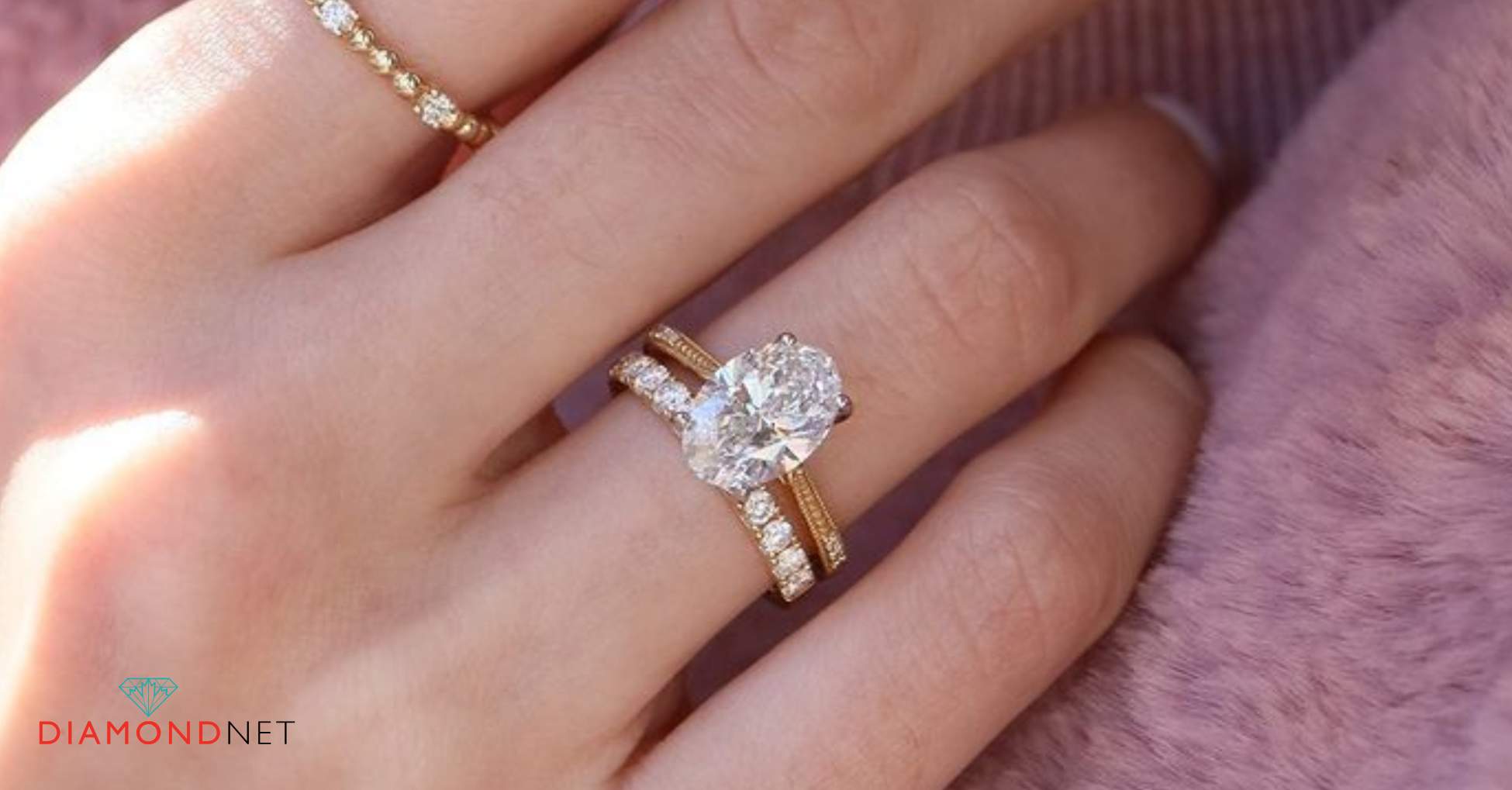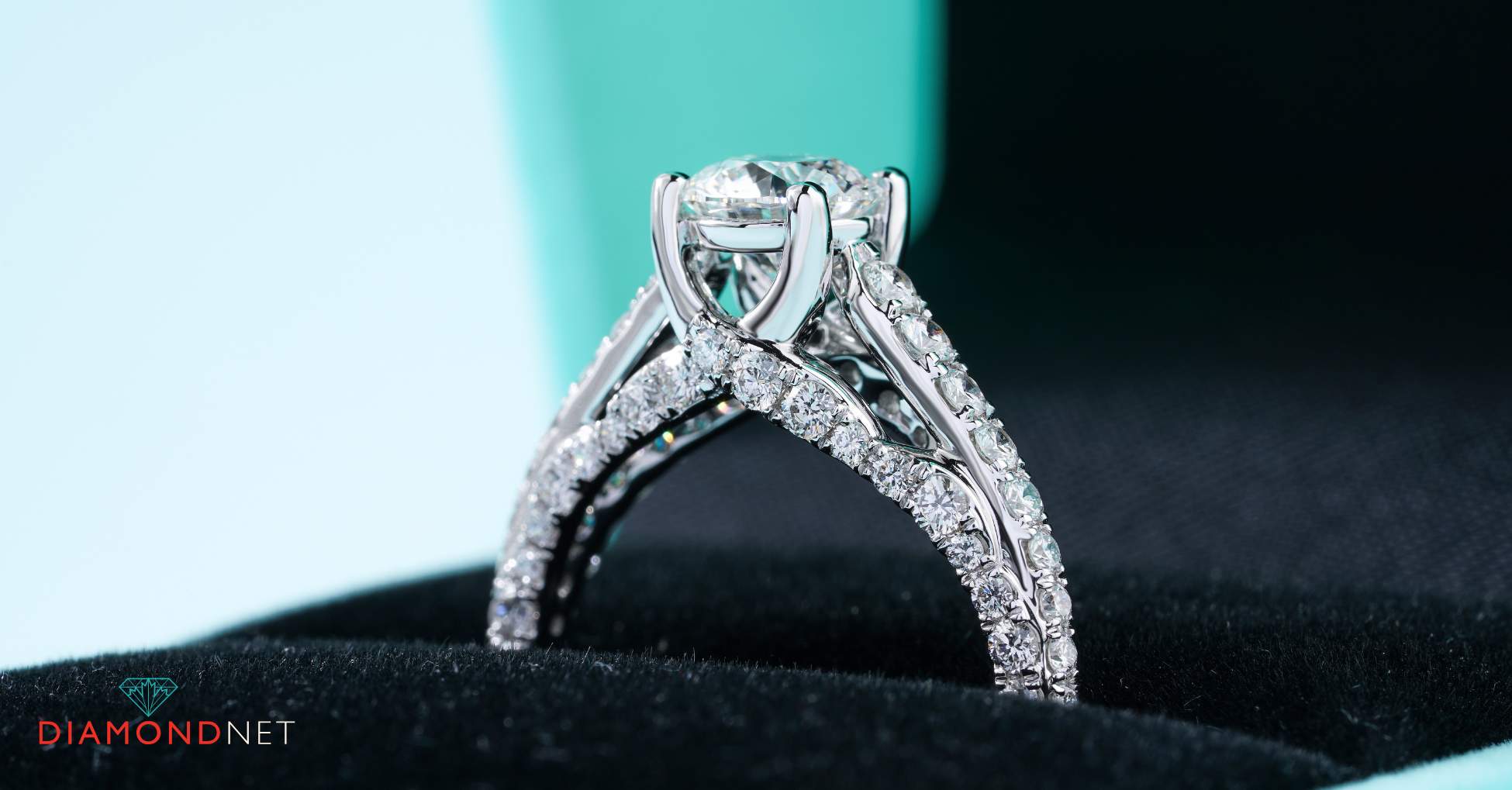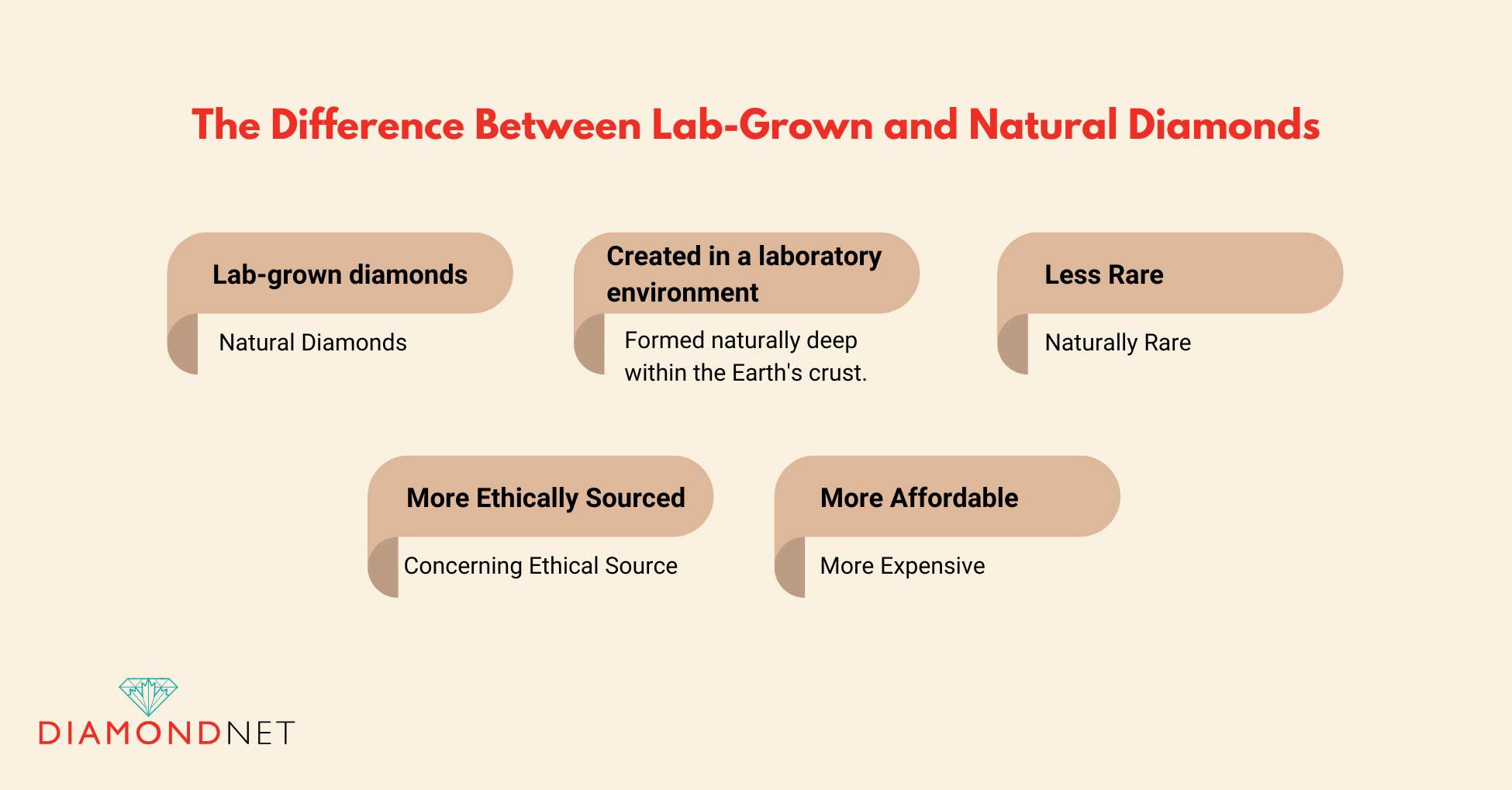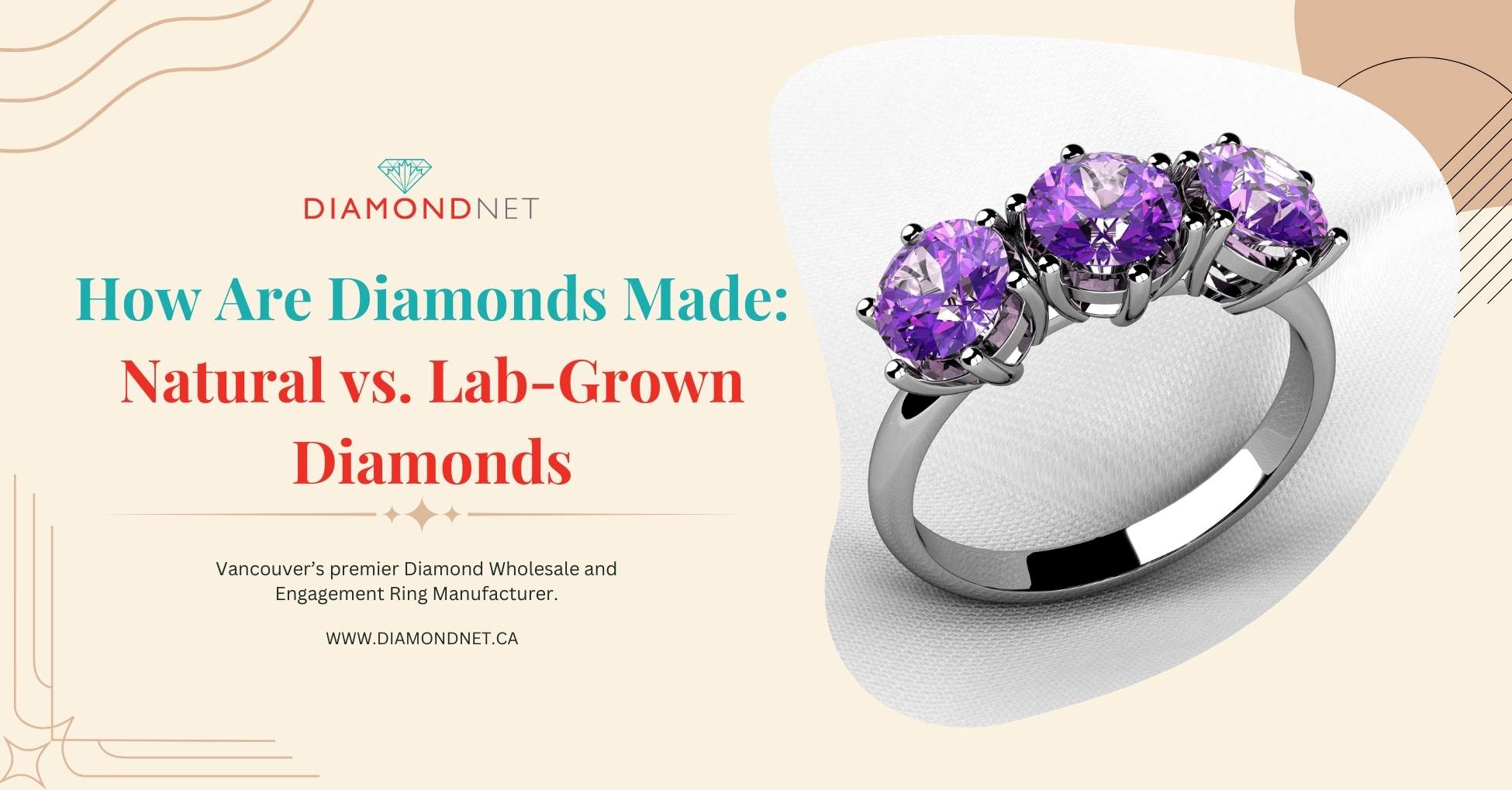Diamonds have stood the test of time, unparalleled by any other stone in their brilliance and hardness, symbolizing eternal love and ultimate luxury. The reality is that not all diamonds are created equal.
Two prominent kinds of diamonds are available today: natural, taking billions of years to form deep in the Earth’s mantle, and lab-grown diamonds, grown through advanced technological processes in weeks.
Understanding the differences between the two types is crucial when making a diamond purchase. In this blog, we will learn how natural diamonds are formed and how lab-grown diamonds are made.
Diamonds: What Are They?
Both diamond and graphite are composed of carbon, yet their atomic structures result in vastly different appearances. It’s surprising that the same element forms these distinct substances.
Coal and graphite, used in pencils, are also made of carbon, but the key difference lies in how their atoms are arranged. In graphite, each carbon atom bonds with three others, while in diamonds, each bonds with four. This tighter bonding in diamonds allows light to pass through, giving them their transparent appearance. In contrast, the loose structure of graphite and coal traps light, making them appear dark and opaque.
Diamonds form under extreme conditions, where carbon atoms are subjected to intense heat and pressure. At temperatures around 1600°C and pressures nearly 50,000 times that of Earth’s surface, the carbon atoms bond in a rigid structure, creating the transparent brilliance diamonds are known for.
The Journey of Diamonds to the Earth’s Surface
Diamonds are formed deep within the Earth’s crust under intense heat and pressure, which takes billions of years. Carbon atoms crystallize under these extreme conditions, giving rise to the precious stones we know and admire.
Diamonds are typically found at depths ranging from 150 to 200 kilometers below the Earth’s surface. In this environment, temperatures soar between 900 and 1,300 degrees Celsius, reaching 45 to 60 kilobars – roughly 50,000 times the atmospheric pressure at the Earth’s surface.
Under these intense conditions, molten lamproite and kimberlite, often referred to as magma, form within the Earth’s upper mantle. These molten substances expand rapidly, forcing their way to the Earth’s surface through the path of least resistance, creating vertical structures known as kimberlite pipes.
As this magma ascends, it carries with it diamond-bearing rocks. Upon reaching the Earth’s surface, the magma cools and hardens, forming kimberlite pipes. These pipes are the primary source of diamonds, although only about 1 in 200 kimberlite pipes contain gem-quality diamonds. The name “kimberlite” derives from the South African town of Kimberley, where the first diamonds were discovered in this type of rock.

How Are Lab-Grown Diamonds Made?
Lab-grown diamonds, also known as synthetic or cultured diamonds, are created in a laboratory environment by miming the natural conditions under which diamonds form deep within the Earth’s crust. While the process is not as time-consuming as the billions of years it takes for natural diamonds to be created, it still requires specialized equipment and precise conditions.
There are two primary methods used to create lab-grown diamonds:
High-Pressure High Temperature (HPHT)
In this process, carbon is placed in a growth chamber under extreme pressure and temperature. It dissolves into molten metal, and the carbon atoms move toward a diamond seed, gradually crystallizing to form a lab-grown diamond. This method mimics the natural conditions of diamond formation, but in a controlled setting.
Chemical Vapor Deposition (CVD)
The Chemical Vapor Deposition (CVD) process is famous for creating lab-grown diamonds. Here’s a closer look at the steps involved:
- Diamond Seed Selection: A small piece of natural diamond, known as a diamond seed, is chosen as the foundation for the lab-grown diamond. The seed is carefully cleaned to minimize the risk of blemishes or inclusions in the final diamond.
- Vacuum Chamber: The diamond seed is placed inside a vacuum-sealed chamber, creating a controlled environment.
- Carbon-Rich Gas: A carbon-rich gas, such as methane, is introduced into the chamber.
- Gas Decomposition: When gas is heated to a high temperature, it breaks down into carbon and hydrogen atoms.
- Diamond Growth: The carbon atoms are deposited onto the diamond seed in a vertical direction, layer by layer. This process continues for several weeks, gradually increasing the size of the diamond.
- Rough Diamond Formation: Once the desired size is achieved, the lab-grown diamond is removed from the chamber. At this stage, it has a rough, uncut appearance.
- Cutting and Polishing: The diamond is polished to reveal its final shape and brilliance.
- Grading: The lab-grown diamond is graded based on its quality characteristics, including carat weight, color, cut, and clarity.
Why CVD is Preferred
The CVD process is often preferred over HPHT for creating lab-grown diamonds due to several advantages:
- Sustainability: CVD requires less energy and is generally considered more environmentally friendly than HPHT.
- Cost-Effectiveness: CVD is often more cost-effective than HPHT, producing more affordable lab-grown diamonds.
- Color Control: CVD allows for greater control over the color of the lab-grown diamond, making it possible to create a broader range of colors.

The Difference Between Lab-Grown and Mined Diamonds
While lab-grown and mined diamonds share the same chemical composition and physical properties, there are some critical differences between them:
Origin
Lab-grown diamonds: Created in a laboratory environment through a process that mimics the natural conditions under which diamonds form.
Mined diamonds: Formed naturally over billions of years deep within the Earth’s crust.
Rarity
Lab-grown diamonds: Can be produced in a controlled environment, making them less rare than mined diamonds.
Mined diamonds: Formed over billions of years under extreme conditions, making them naturally rare.
Ethical Considerations
Lab-grown diamonds: Often considered more ethically sourced, as they do not involve the same mining practices and potential human rights issues associated with mined diamonds.
Mined diamonds: The ethical sourcing of mined diamonds has become a growing concern, with organizations like the Kimberley Process working to ensure that diamonds are not used to fund conflict.
Mined Diamonds vs. Lab-Grown Diamonds Price
Mined, or “natural,” diamonds tend to be more expensive than lab-grown diamonds, largely due to the influence of a few key players in the diamond industry who control prices and regulate the supply. Mined diamonds also require more resources and labor to produce and are more widely recognized, which contributes to their higher prices.
In contrast, lab-grown diamonds are often priced significantly lower. Their production involves fewer resources and less labor, and since they are renewable, the costs remain more manageable, making them a more affordable alternative to mined diamonds.

Unlock the Value of Your Diamonds with DiamondNet
Are unwanted diamonds in a drawer or tucked away in your jewelry box? Maybe an heirloom you never wear or a diamond you inherited that isn’t your style? At DiamondNet, we have developed a safe, convenient, and transparent way to sell your diamonds online and unlock their full potential.
Why DiamondNet is the Best Place to Sell Your Diamonds
At DiamondNet, we make the selling process quick and simple, with no need for an appointment. You can receive a free online appraisal within minutes. Our GIA-certified gemologists provide expert assessments to guarantee a fair and accurate price for your diamond.
We also ensure secure transactions with insured payments and safe shipping for your peace of mind. Additionally, we are committed to ethical sourcing and responsible operations, ensuring that your diamonds find a new home in a sustainable manner.
Visit DiamondNet.ca today and get a free personal consultation. Our friendly customer service team is happy to answer any questions about selling your diamonds. Don’t let your diamonds gather dust! Turn them into cash and discover a world of possibilities with DiamondNet.
FAQs
1. How long does it take to form a diamond?
The formation of a diamond occurs naturally over 1 to 3.3 billion years. In contrast, lab-grown diamonds usually develop in less than a month.
2. Are diamonds made of carbon?
Yes, diamonds are composed of carbon. Formed by great heat and pressure deep within the Earth’s crust, the carbon atoms crystallize into the hard, transparent substance we know as diamonds.
3. Can real diamonds be man-made?
Yes. ‘Natural’ diamonds and lab-grown diamonds are chemically identical. The method of creating a lab-grown diamond, which takes a few months rather than millions of years, involves scientists simulating the identical conditions found in nature.



